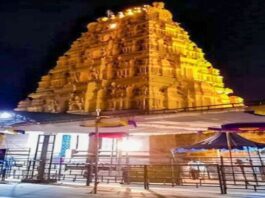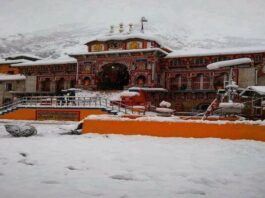Introduction
Mysteries of Bagheswari Temple: Nestled amid the lush green geographies of India, the Bagheswari Temple stands as a testament to the country’s rich artistic heritage and religious significance. Positioned in the eastern state of West Bengal, this ancient tabernacle is a symbol of devotion, architectural brilliance, and literal significance. Bagheswari Temple holds multitudinous interesting mystifications and legends that have charmed the minds of chroniclers, archaeologists, and addicts for generations. In this blog, we will embark on a trip to explore the witching history, architectural sensations, and unsolved mysteries of the Bagheswari Temple.
Literal Background
The Bagheswari Temple, also known as the Bagha Raya Temple, dates back to the 12th century during the rule of the Sena dynasty. It’s positioned in the city of Bishnupur, which was formerly the capital of the Malla lords. The tabernacle is devoted to Goddess Bagheswari, a manifestation of Goddess Drugs, who is worshiped as a fierce and defensive deity.
The Malla lords were great patrons of art, culture, and armature. They erected multitudinous tabernacles and terracotta structures that still stand moment as an architectural heritage. Bagheswari Temple, with its unique style and design, is a remarkable illustration of the architectural prowess of the Malla dynasty.
Architectural Sensations
The Bagheswari Temple is famed for its unique structure and intricate terracotta artwork. The Tabernacle follows the ekaratna( single pinnacle) style, characterized by a single palace or Becket. Its red-slip-up construction, adorned with detailed terracotta busts, sets it piecemeal from other tabernacles in the region.
The tabernacle’s intricate terracotta panels depict scenes from Hindu tradition, occurrences from the Ramayana and Mahabharata, and colorful aspects of diurnal life during the medieval period. Each panel narrates a story, creating a mesmerizing visual shade that reflects the cultural brilliance of the tradesmen of that period.
Mystifications and Legends
Despite being a well-known passage point, Bagheswari Temple harbors some mystification and legends that continue to intrigue experimenters and callers
a) The Hidden Underground Passage According to original legends, the tabernacle is said to be connected to a vast underground network of coverts that lead to the colorful corridor of Bishnupur and beyond. Still, no substantial substantiation has been set up to confirm the actuality of these passages, adding an air of riddle to the Tabernacle’s history.
b) The fading Pinnacles Some chroniclers believe that the tabernacle first had multiple pinnacles, but over the centuries, several of them have mysteriously faded. The reason behind their exposure remains unknown, fueling enterprise and wonder.
c) The Curse of the Tiger The name” Bagheswari” translates to” Tiger Goddess.” Legend has it that a fierce barracuda formerly guarded the tabernacle firmaments. The locals deified the barracuda as the protection of the Tabernacle. Still, when the barracuda faded under mysterious circumstances, it was believed to be a sign of brewing disaster.
d) The Devi’s Blessings Addicts visiting Bagheswari Temple frequently relate passing in explainable passions of peace and tranquility. Some claim to have been blessed with wishes coming true after offering prayers to the Goddess. The explainable spiritual air of the Tabernacle leaves numerous questioning the godly presence within its walls.
Religious Significance
Bagheswari Temple holds immense religious significance for addicts, particularly during the Navratri jubilee when the entire city of Bishnupur comes alive with vibrant fests. During this auspicious occasion, the Tabernacle attracts thousands of addicts from far and wide who come to seek the blessings of Goddess Bagheswari.
The Tabernacle’s serene air and literal heritage make it not only a point of religious significance but also a must-visit destination for history suckers and armature sweeties.
Conservation Sweats
Over time, Bagheswari Temple has faced a mass of natural rudiments and mortal conditioning. The terracotta busts have suffered from riding and decay, taking expansive conservation sweats. Organizations, both governmental and non-governmental, have taken up the responsibility of conserving this architectural phenomenon.
Enterprise has been launched to restore the Tabernacle’s original splendor and cover its unique terracotta artwork for unborn generations to respect and appreciate.
Conclusion
The Bagheswari Temple stands as an admiration-inspiring testament to the majesty of India’s artistic heritage and architectural brilliance. As we claw into its history and explore its enigmatic mystification, we find ourselves transported to a period where art, devotion, and church were seamlessly intertwined.
Moment, as the tabernacle faces challenges, it’s the collaborative responsibility of society to save this precious heritage. The mystification that compass the Bagheswari Temple add to its charm and appeal, leaving us with a sense of wonder and admiration for the unknown secrets that lie within its walls.
In visiting this ancient tabernacle, we not only connect with our history but also gain a deeper understanding of the traditions and beliefs that have shaped the different shade of Indian culture. As the Bagheswari Temple continues to stand altitudinous, it reminds us of the dateless beauty that resides in our literal gems, staying to be explored and cherished for generations to come.
FAQs
1. What’s the Bagheswari Temple, and where is it located?
Answer: The Bagheswari Temple, also known as the Bagha Raya Temple, is an ancient Hindu tabernacle devoted to Goddess Bagheswari, a manifestation of Goddess Durga. It’s located in the city of Bishnupur, West Bengal, India.
2. What’s the literal significance of the Bagheswari Temple?
Answer: The Bagheswari Temple dates back to the 12th century and was erected during the reign of the Malla dynasty. It stands as a symbol of the architectural brilliance and cultural heritage of the Malla lords, who were great patrons of art and culture.
3. What’s the Architectural Style of the Bagheswari Temple?
Answer: The Bagheswari Temple follows the ekaratna( single pinnacle) architectural style, characterized by a single palace or Becket. It’s made of red slip-up and is adorned with intricate terracotta busts.
4. What are the Unique Features of the Tabernacle’s Terracotta Artwork?
Answer: The tabernacle’s terracotta panels depict scenes from the Hindu tradition, occurrences from the Ramayana and Mahabharata, and colorful aspects of diurnal life during the medieval period. Each panel narrates a story, creating a visually witching shade.
5. Are there Any Mystification Associated with the Bagheswari Temple?
Answer: Yes, the Tabernacle has several interesting mystifications and legends. These include the belief in retired underground passages, the exposure of pinnacles, and the legend of the curse of the barracuda that formerly guarded the Tabernacle.
6. How Significant is Bagheswari Temple during the Navratri Jubilee?
Answer: Bagheswari Temple holds immense religious significance during the Navratri jubilee. Addicts from the colorful corridor of India visit the Tabernacle to seek the blessings of Goddess Bagheswari during this auspicious occasion.
7. How are Sweats Being Made to Save the Tabernacle’s Heritage?
Answer colorful governmental and non-governmental associations have taken up the responsibility of conserving the Bagheswari Temple. Enterprise is underway to restore the Tabernacle’s original splendor and cover its unique terracotta artwork from riding and decay.
8. What Spiritual Gests Do Callers Frequently Report at Bagheswari Temple?
Answer Callers frequently report passing passions of peace, tranquility, and a sense of godly presence within the Tabernacle demesne. Some addicts claim to have had their wishes fulfilled after offering prayers to Goddess Bagheswari.
9. How Does the Bagheswari Temple Contribute to India’s Artistic Heritage?
Answer The Bagheswari Temple is a remarkable illustration of India’s rich artistic heritage, architectural brilliance, and literal heritage. It represents the cultural and religious traditions that have shaped the country’s different artistic shades.



